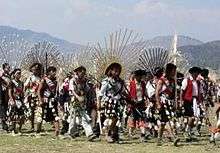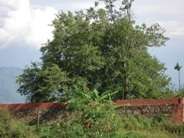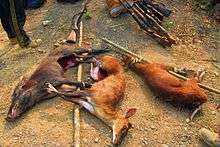Poumai Naga
The Poumai Naga is one of the major Naga tribe in northeastern state of Manipur in India.
 Glory Day celebration of the Poumai Naga | |
| Total population | |
|---|---|
| 187,180 (2011 census) | |
| Regions with significant populations | |
| Manipur | 127,381[1] |
| Nagaland | 6000-10,000[2] |
| Languages | |
| Poula | |
| Religion | |
| Predominantly Christianity | |
| Related ethnic groups | |
| Mao Naga | |
The Poumai predominantly live in the Senapati District of Manipur, though there are villages in Nagaland state. The Poumai mainly live in 100 villages that have been broadly divided into three blocks: Paomata, Lepaona and Chilivai.
The Poumai speak their own language, Poula, and are generally Christians.
Legal statue
In 2003, the Government of India proclaimed the Poumai Naga to be a separate tribe. Paomata, Lepaona and Chilivai, taken together are recognised as Poumai Naga .Prior to that, the government considered them to be part of the Mao tribe, with whom they share culture and history.
As of 2011, the Poumai tribe had a population of 179,189, with 10,000 living in the Phek district, Nagaland. There are 94 Poumai villages, of which 85 are revenue-recognised villages and nineare unrecognized.
The Poumai villages wholly cover three sub-divisions: Paomata SDO/BDO, Purul SDO/BDO, Chilivai SDO/BDO, Phaibung and 1/3 of Mao-Maram, Tadubi Sub-Division. Some of the Poumain villages are under Kangpokpi Sub-Division and some in Phek District of Nagaland.
Folkore

According to Poumai folklore. after the tribe migrated to Makhel (Mekhro), a Poumai leader thrust his walking stick on the ground. This stick took root and sprouted into a large wild pear tree called "Khyataobii". The tree still stands in Khyako; when a branch breaks, the local Poumai inhabitants, called "Tenyimia", must observe genna and take a holiday.
Oral history accounts reveal that the first Poumai settler in Makhel was Khyapou Dukhuo and Supou Paoyuo, was the first at Saranamai. The Lepaona group settled down at Koide under the chieftainship of Napou-Rakhuo. The Proupuozei group (Proumai) migrated from Makhel and settled at Proufii (West of the Khyouchi-Liila range) for a short period, then resettled at Phaofii (Kodom).
Koide villagehas a "Holy Well" known as Shodziikhao on the eastern side of the village. It is said that the water of this Well is used for the sanctification of birth rituals, important gennas and marriage ceremonies. The Well, which remains perennial throughout the year, exists even today.
Over the generations, the Poumais spread out to different regions. The Maram and Thangal tribes migrated towards the southwest. The Paomata, Lepaona and Chilivai settled at Süfü, now known as "Saranamai". From Süfü, one group settled at Nafü, now known as Koide.
Locations of villages and social background
Poumai villages were traditionally situated on hill tops or ridges. This was for security reasons, as tribal warfare and headhunting was frequent. The villages were surrounded by stockades and fortified trenches. After the British colonial government suppressed warfare, these defenses were no longer maintained. However, taces of such constructions can still be seen today.
Poumai houses are usually built in rows facing each other. Each house has a garden in the backyard for growing vegetables, fruits, sugarcane, bamboos, etc. Boys and girls sleep in groups in a house called Khoukivei or Reipeiki. The houses are decorated with buffalo skulls and man-on-the-planks sculptures.
Powers and functions of the chieftain (Mave-o)
Every Poumai village is independent. The village is nominally ruled by the Mave-o (Chieftain) and he may best be described as "nominal head" of a small state. He is the custodian of customs and traditions. The Mave-o makes decisions through open discussion with clan elders are highly respected in the village. In theory, the Mave-o's power and function is based on the principle "if the chieftain is poor the villagers as well as the village prosper".
Whenever a Poumai in the village slaughters an animal for a feast, he must donate a limb of the slaughtered animal and two tins of paddy to the Mave-o as a gesture of respect and gratitude. On such a day, the donois allowed to wear the prestigious shawl Hahsha called Yeshosha (a white shawl with big stitches in the middle). A stone would be erected to commemorate the occasion.
The Mave-o also announces and initiates the time for cultivation.
Family life
The Poumai Naga family life is patriarchal in nature. The father is the head of the family and he not only represents the family in all matters but is also the bread earner of the family. The mother's duty is to raise the children properly and to look after household chores such as cooking, washing, and collecting firewood. The children look after their parents' daily chores. From morning till dusk the children are surrounded by educational activities.
The Poumai Nagas have many dances, songs and performing arts. The most popular dances are Asah-do (prosperity dance), Rieh-do (war dance), Tahta-do (ploughing demo dance), Mate-do (seed sowing dance), and Chachu-do (harvest dance).
Thounii Festival
Thounii has multifaceted meanings and significances. The name of the festival derives from the word 'Thouniikhou' which is the first month of the year. The word “Thou” means “new”; “nii” means “festival”. Therefore, it can be translated as “New year festival or the festival of dawn”. It is celebrated after storing up paddy and all kinds of food grains and crops. The festival is an occasion of thanksgiving to our deity for good harvest and good health. One of the reasons why Thounii is considered the biggest and grandest festival is because of the attribution of pleasant climate, availability of abundant foods, drinks and festive mood of the people. Thounii also marks the initiation of a new village settlement after considering the various aspects and observation of omens, dreams, signs, divinations, etc.
In the past, Thounii celebration lasted for five days commencing from 18th to 22nd of Thouniikhou. The first day of the festival is known 'SHAA’. The day was marked as the preparation day for the festival. The house, village surrounding, street, public park, etc. were cleaned, repaired and set in order for public gathering. The prepared rice beer vessels for the feast were tasted and blessed on this day. In the evening the family members sat down together and baked bread on a flat stone and were mixed with sesame cream for better taste.
The second day of the festival is known 'CHIZIIYU' means the sanctification of house. All animals for consumption during the feast were slaughtered and divided among relatives and neighbours. Libation and Oblation were performed at the corner of the house called Rii (family altar) by head of the family with cooked meat and rice beer served on plantain leaf to the family deity as thanksgiving for the bountiful harvest. The guests, sisters and relatives from the neighbouring villages arrived in the evening and the feast of eating and drinking began by lighting bonfire in public ground.
The third day is known 'SHEPAO' means sent off the guest. The brothers presented cooked meat to newly married sisters which were offered to her husband's relatives. The guests, sisters and relatives who attended the festival were dropped off till the village boundary. The youth played and participated in traditional games and dances during the day time and re-gathered in the evening at public park for drinks, singing, dancing, narrating stories of heroic deeds of forefathers, history of origin, migration and listened to the exhortation of the elders.
The fourth day is known 'NIIDAI’ means day four of the festival. The menfolk went around the village whooping in full traditional attires and the whole villagers came to the public ground in the evening with their rice beer and food stuffs. The youth collected firewood and made bonfire at night where the villagers gathered and shared their foods and drinks with one another. Eating, drinking, merriment and various cultural events continued.
The fifth day is known 'NIINGOUTO' means the last day of the festival. On this day, the village menfolk went to the jungle to chase and catch a particular bird called 'Seitu' with bare hands. No weapons like gun, bow, arrow, spear or catapult, etc. were used while catching this bird. The one who caught the bird was considered the lucky man of the year. He beheaded the bird and body was then thrown to the group which torn into pieces and shared among the group members and the members who did not got the flesh piece were shared the feathers and stained blood on their pole. As they returned, they went around the village in whoop, signifying victory over the adversary and later the pole were erected at the village gate. When no bird was caught on the first day, hunting continued the next day till the bird is caught. Thus, the festival came to an end. Thounii heralds the coming of spring and reminds the farmers to go back to work in the fields.
Musical instruments
The Poumais have only a few musical instruments:
- Hraoloubüii/Gaigou: a single stringed Banjo made of a dried bottle-like gourd shell
- Chü: indigenous flute made of bamboo
- Hakai: buffalo horn
- Ahbe: a wind musical instrument
- Hachha: a wind musical instrument
- Ahtsii: a wind musical instrument
The Hraoloubüii/Gaigou, Ahbe, Machha and Makai are usually played by man. Traditional folk songs are sung with or without the accompaniment of instruments.
Dress
At the turn of the century, with modernity yet to make its entry, men's dress was very simple. It consisted of a kilt and a cloth. Most of the time they remained half-naked except on grand occasions. During festivals, they wore Roh-lai (diadem), Vee-hoxzü (a colourful bird's feather), Phao-hah, paongi (ivory bangles), etc. Women wore Lakiteisha (a black shawl with red and green stripes), Poüpumü (a white-skirt with black and green stripes), Bao-sa (bangles), Baoda (a brass bangle), and Toutah or Tou (necklaces). The grills could also be woven from the barks of nettle.
Food and drinks

To the Poumais, food means cooked rice. They eat three heavy meals a day. As well as rearing domestic animals for food, they also hunt wild animals and birds. Rice beer, called Pou-yu or "Pou-zhao" in Poumai, is a very popular drink among the Poumais. They have been skilled in brewing it from time immemorial. Most of the elders, both men and women, chew tobacco. Some of them also use hooks or hubble.
Pottery
Amongst the tribesman of Poumai, the inhabitants of Onaema(Oinam Hill) make the earthen pots and utensils called Pouli. Some of the utensil items made by them are the tooly (rice pot), vuly (curry pot), naikhaoti (curry bowl), khouli (pitcher), duki (oar) and ngaki, (a big jar for fermenting rice beer).
River
Important rivers like Vourei ( Barak), Ngarei ( Laini) and Phaomai Sorei (Iril) originate from hill range and provides water to all the regions of Poumai.
Calendar
|
Week Days
|
Months
|
References
- "A-11 Individual Scheduled Tribe Primary Census Abstract Data and its Appendix". www.censusindia.gov.in. Office of the Registrar General & Census Commissioner,India. Retrieved 18 November 2017.
- Veikho, Sahiinii Lemaina. "Poula phonetics and phonology: An Initial overview (Poumai Naga)". North East Indian Linguistics (NEIL) 7.
External links
- https://thohepou.wordpress.com/category/poumai-naga-tribe/
- https://web.archive.org/web/20140427005532/http://poumainaga.com/wiki/poumai-naga-tribe/
- https://web.archive.org/web/20140427005529/http://poumainaga.com/wiki/poumaipedia/poumai-villages/
- https://web.archive.org/web/20110825011032/http://poumai.wetpaint.com/page/Poumai+Naga
- https://web.archive.org/web/20120328065058/http://classic.kanglaonline.com/index.php?template=kshow&kid=298&Idoc_Session=1b22ddd2873ef8925aed15a52b69a133
